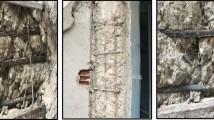Abstract
A macroscopic model evaluating shear behavior is necessary to simulate the failure process of shear walls under different axial compression ratios and different out-of-plane bending moments. Accordingly, based on the results of experiments and numerical simulations, a three-segment skeleton curve model was established to reflect the relationship between shear force and deformation when a reinforced concrete shear wall is subjected to axial and horizontal force. Corresponding hysteresis rules were proposed to obtain a macroscopic hysteresis model of the shear wall. Comparison between numerical and experimental results showed that the peak displacement, ductility, and hysteresis characteristics determined using the macroscopic model matched the experimental results well. The numerical results of the macroscopic shear model showed that the in-plane shear performance of a shear wall is almost unchanged when the out-of-plane displacement is very small, but if the displacement along the thickness direction increases, the in-plane shear bearing capacity and the deformation ability of a shear wall will notably decrease. The results can be used for structural design or collapse simulation.














Similar content being viewed by others
References
Bakhtiari, H., Karimi, M., & Rezazadeh, S. (2016). Modeling, analysis and multi-objective optimization of twist extrusion process using predictive models and meta-heuristic approaches, based on finite element results. Journal of Intelligent Manufacturing, 27, 463–473. https://doi.org/10.1007/s10845-014-0879-6.
Cai, M., Gu, X., Hua, J., et al. (2011). Seismic response analysis of reinforced concrete columns considering shear effects. Journal of Building Structures, 32(11), 97–108.
Dang, X., Lu, X., Qian, J., & Jiang, H. (2014). Finite element analysis with solid and plane element of seismic performance of self-centering pre-stressed shear walls. Journal of Building Structures., 35(5), 17–24.
Epackachi, S., Whittaker, A. S., & Aref, A. (2017). Seismic analysis and design of steel-plate concrete composite shear wall piers. Engineering Structures, 133, 105–123.
Fan, X., & Pu-sheng, S. (2010a). Mechanical analysis of multi-vertical-line-element model of RC shear-walls and its improvement. Engineering Mechanics, 27(6), 77–82.
Fan, X., & Pu-sheng, S. (2010b). A new type of multi-vertical-line-element model of shear walls: Principle and application. Engineering Mechanics, 27(9), 154–160.
Gao, L., Xu, G. Q., & Chen, J. N. (2011). The analysis of judging criterion and the influence of shear-span ratio to the failure model in frame short column. Applied Mechanics and Materials, 94–96, 913–917.
Gu, X. L., Wang, X. L., Yin, X. J., et al. (2014). Collapse simulation of reinforced concrete moment frames considering impact actions among blocks. Engineering Structures, 65, 30–41.
Halil, S. (2008). Shear deformation model for reinforced concrete columns. Structural Engineering and Mechanics, 28(1), 39–52.
Jünemann, R., de la Llera, J. C., Hube, M. A., et al. (2016). Study of the damage of reinforced concrete shear walls during the 2010 Chile earthquake. Earthquake Engineering and Structural Dynamics, 45(10), 1621–1641.
Lowes, L. N., Lehman, D. E., & Whitman, Z. (2019). Investigation of failure mechanisms and development of design recommendations for flexural reinforced concrete walls. Engineering Structures, 186, 323–335.
Oztemel, E., & Gursev, S. (2020). Literature review of Industry 4.0 and related technologies. Journal of Intelligent Manufacturing, 31, 127–182. https://doi.org/10.1007/s10845-018-1433-8.
Setzler, E. J., & Sezen, H. (2008). Model for the lateral behavior of reinforced concrete columns including shear deformations. Earthquake Spectra, 24(2), 493–511.
Snchez-Alejandre, A., & Alcocer Sergio, M. (2010). Shear strength of squat reinforced concrete walls subjected to earthquake loading trends and models. Engineering Structures, 32(8), 2466–2476.
So, M., Harmon, T. G., & Dyke, S. (2010). FEA implementation of smeared cyclic bond slip-based two-dimensional membrane model. ACI Structural Journal, 107(1), 92–100.
Tibaut, A., Rebolj, D., & Nekrep Perc, M. (2016). Interoperability requirements for automated manufacturing systems in construction. Journal of Intelligent Manufacturing, 27, 251–262. https://doi.org/10.1007/s10845-013-0862-7.
Weiyi, Z., Quanquan, G., Zeyu, H., et al. (2016). Hysteretic model for steel-concrete composite shear walls subjected to in-plane cyclic loading. Engineering Structures, 106, 461–470.
Xiaoyan, W. A. N. G., Wensheng, L. U., & Jianping, H. A. N. (2018). FEA on one-story single-bay self-centering steel-centering steel plate shear walls. Journal of Building Structures, 39(4), 65–73.
Acknowledgements
This work was financially supported by the National Natural Science Foundation of China (90715004).
Author information
Authors and Affiliations
Corresponding author
Additional information
Publisher's Note
Springer Nature remains neutral with regard to jurisdictional claims in published maps and institutional affiliations.
Rights and permissions
About this article
Cite this article
Fu, W. Macroscopic numerical model of reinforced concrete shear walls based on material properties. J Intell Manuf 32, 1401–1410 (2021). https://doi.org/10.1007/s10845-020-01620-y
Received:
Accepted:
Published:
Issue Date:
DOI: https://doi.org/10.1007/s10845-020-01620-y




